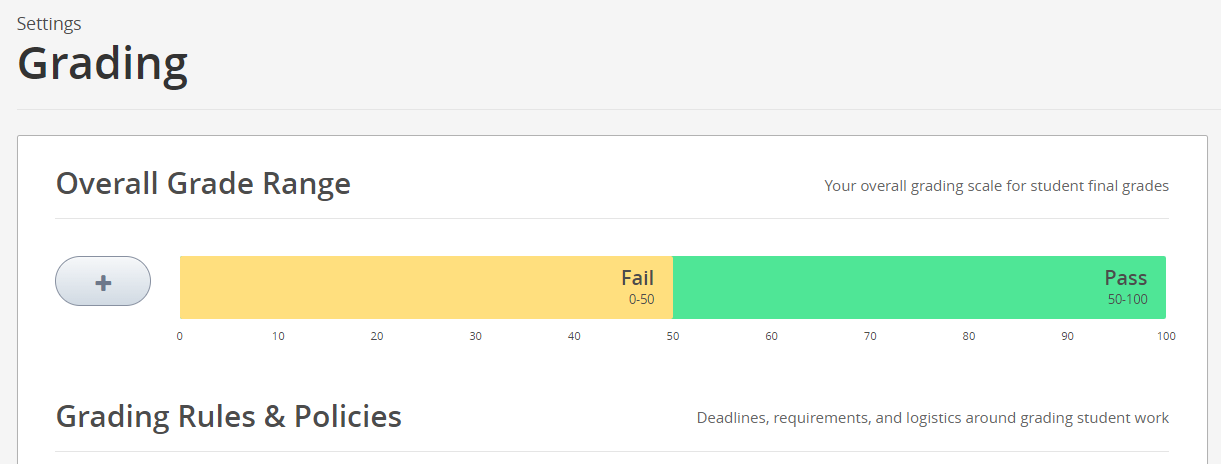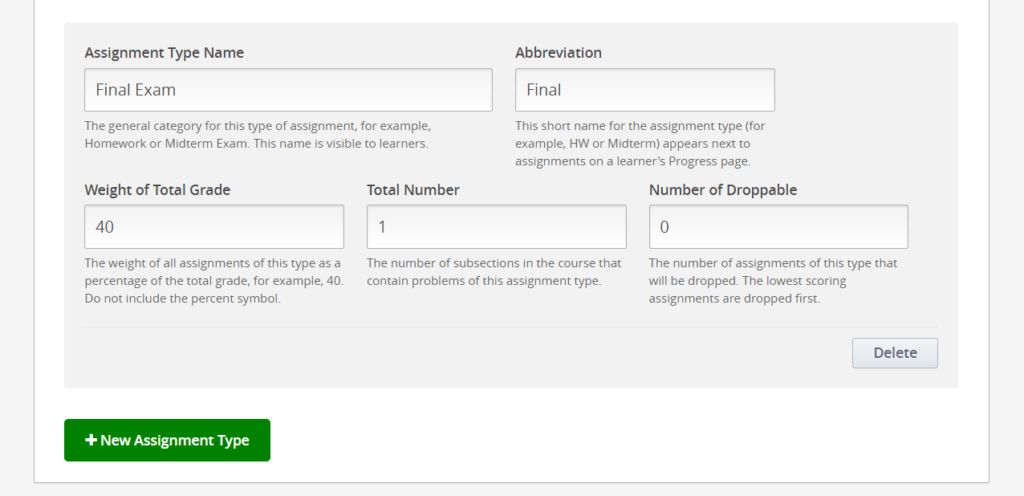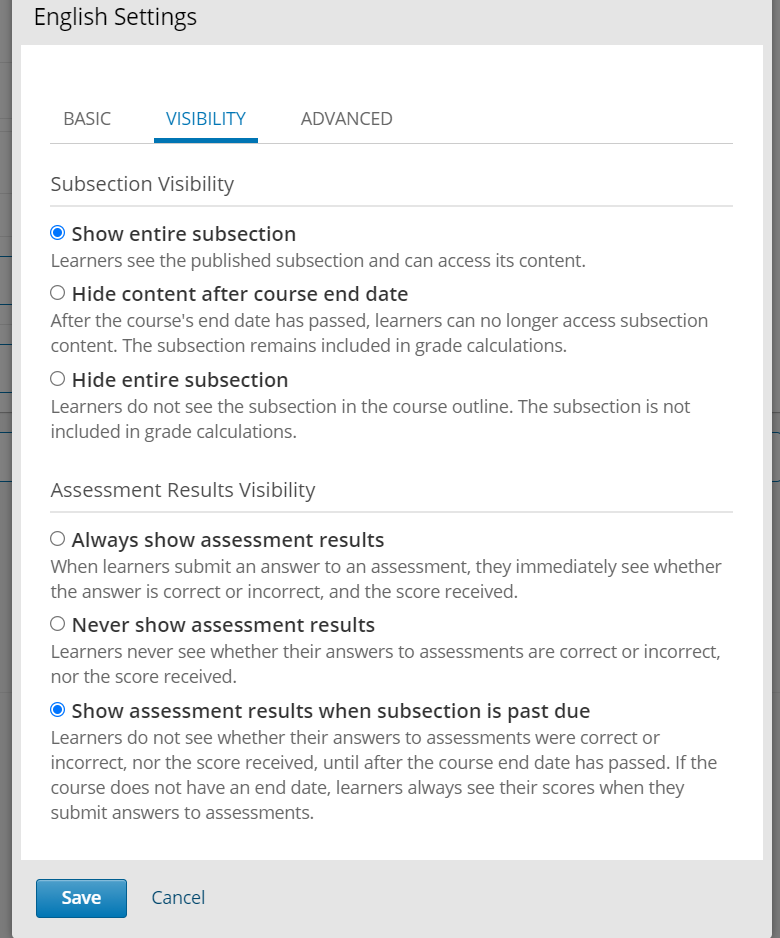Establishing a Grading Policy For Your Course
Use the topics in this section to learn about setting up grading for your course. Establishing a grading policy requires several steps, including deciding whether to include ungraded sections in your course.
Important: Any changes to the course grading policy, to graded subsections, or to graded components after a course begins will affect the student experience in the course and analysis of its data.
This section includes the following information about course grading.
- Set the Grade Range
- Set the Grace Period
- Configure the Assignment Types
- Graded Subsections
- The Learner View of Grades
Set the Grade Range
You must set the grade range for the course. For example, your course can be pass/fail, or can have letter grades A through F.
To set the grade range, from the Settings menu, select Grading.

The control for the grade range is at the top of the Grading page.

The above example shows that you have a pass/fail grade range, with a score of 50 as the cutoff. This is the default setting for a new course.
You can adjust the grade range as needed.
- To add a grade in the range, select the + icon. A new grade is added to the range between the existing grades. For example, if you add a grade in the default setting, the grade range changes to F (0 to 50), B (50 to 75), and A (75 to 100):

- To change the score range, move the cursor over the line dividing two grades and then select and drag the line left or right.
- You can see the range numbers of the two grades adjacent to the line change. Unselect the line when it is where you want it.
- To change the name of the grade, select the current name of the grade and start typing the name of the new grade. For example, if the original name of the grade is “Pass”, you can select “Pass” and then type “Excellent” to replace the name.
- You cannot change F or Fail.
- To remove a grade, move the cursor so that it is over the grade.
- A remove link appears above the grade. Select the link.
- You cannot remove F or A.
After you make any changes to the grade range, you must select Save Changes at the bottom of the page.

Note: If you plan for your course to offer certificates, note that a learner will qualify for a certificate by earning any grade over the F, or Fail, threshold. This is true regardless of how many grade levels you add in the grade range.
Set the Grace Period
You can set a grace period that extends homework due dates for your learners. The grace period applies to the whole course; you cannot set different grace periods for individual assignments.
Note: The grace period setting does not apply to the following assignments and exams:
- Timed exams.
- Proctored exams.
- Open response assessments.
On the Grading page, under Grading Rules & Policies, enter a value in the Grace Period on Deadline field. Enter the value in HH:MM format.

Configure the Assignment Types
You must create assignment types for your course and determine the weight of the total grade for each assignment type.
For example, you might have the following assignment types.
- 10 homework assignments, worth a total of 50% of the grade;
- A midterm exam, worth a total of 20% of the grade;
- A final exam, worth 30% of the grade.
By default, a new course has the following four assignment types.
- Homework
- Lab
- Midterm Exam
- Final Exam
You can use these assignment types, modify or remove them, and create new assignment types.
To create a new assignment type, in the bottom of the Grading page, select New Assignment Type, then configure the fields described below.

You configure the following fields for each assignment type.
- Assignment Type Name:
The general category of the assignment. This name will be visible to learners.
Note: All assignments of a particular type count the same toward the weight of that category. As a result, a homework assignment that contains 10 problems is worth the same percentage of a student’s grade as a homework assignment that contains 20 problems.
- Abbreviation:
This is the short name that appears next to an assignment on a learner’s Progress tab.
- Weight of Total Grade:
The assignments of this type together account for the percent value set in Weight of Total Grade.
The total weight of all assignment types must equal 100.
Note: Do not include the percent sign (%) in this field.
- Total Number:
The total number of subsections in your course that contain problems of this assignment type.
- Number of Droppable:
The number of assignments of this type that the grader will drop. The grader will drop the lowest-scored assignments first.
Graded Subsections
After you configure assignment types, as you are organizing your course, you set the assignment type for subsections that contain problems that are to be graded.
You can set assignment types and due dates at the subsection level only. You cannot set assignment types or due dates for entire sections or for individual units within subsections. Additionally, you can designate a subsection as one, and only one, of the assignment types you configured.

The subsection level is also where you specify whether you want learners to receive immediate results when they complete problems in the subsection, or if you want to hide the results temporarily or permanently

Note:
- You can create problems in Studio without specifying an assignment type for the subsection. Scores for such problems are listed as “practice scores” on the learner’s Progress page and do not count toward the learner’s grade.
- Hidden sections, subsections, or units that contain graded content are not included in grading and also do not count toward a learner’s grade.
Within a graded subsection, you create problems of the type designated for that subsection. You cannot mix problems of different assignment types in the same subsection.
For example, if you want to create a homework assignment and a lab for a specific topic, create two subsections. Set one subsection as the Homework assignment type and the other as the Lab assignment type. Both subsections can contain other content as well as the actual homework or lab problems.
The Learner View of Grades
After a grading policy is in place, learners can view both their problem scores and the percent completed and current grade on the Progress page for the course.

Note: If you have hidden the problem results for some assignments, these scores are not visible on the Progress page. The page shows only that the learner has completed the assignment.
Each item in the X axis of the chart is for a graded subsection. Graded problems in units are not broken out in the chart; the score from each problem in the subsection is added to that vertical bar.
Graded subsections are grouped in the chart by assignment type rather than listed in chronological order. For example in the above chart, all Vocabulary exercises are grouped together, followed by Comprehension, then Grammar.
